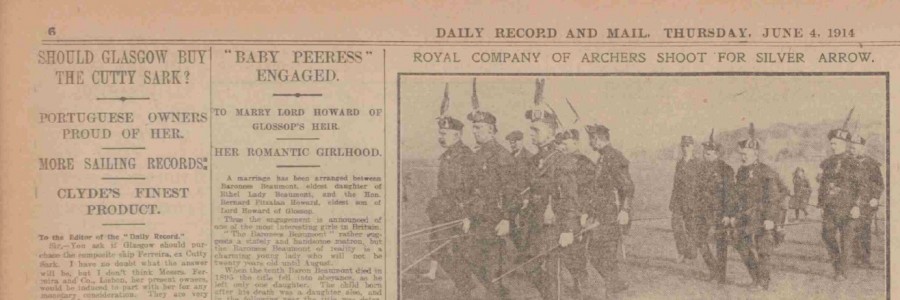SHOULD GLASGOW BUY THE CUTTY SARK?
PORTUGUESE OWNERS PROUD OF HER
To the Editor of the “Daily Record.”
Sir. – You ask if Glasgow should purchase the composite ship Ferreira, ex Cutty Sark. I have no doubt what the answer will be, but I don’t think Messrs. Ferreira and Co., Lisbon, her present owners, would be induced to part with her for any monetary consideration. They are very proud of her.
Only two days ago I received a letter from them telling me that the Ferreira had arrived at Liverpool with one record more – 59 days Mossomedes, West Coast of Africa to Liverpool.
They added – “This fast vessel has made in our hands several voyages, and we can give you the following – Lisbon to St. Paul de Loanda 31 days; Lisbon to Delagoa Bay 53 days; New Orleans to Lisbon 29 days; and many others.”
I only saw the Cutty Sark once. That was in London 22 years ago. She was then the centre of attraction as she lay alongside her sister ships the Dharwar, Blackadder and Coldinghame. They were then all owned by Messrs. John Willis and Co., London, who disposed of all their fleet a few years later.
The Ferreira is the only one of them now afloat. Another composite vessel is registered at Lisbon, but owned in Oporto. She is the barque Emilia and was launched at Port-Glasgow by R. Duncan and Co. at the Otago three month before the Cutty Sark was launched at Dumbarton.
ALL THAT IS LEFT OF THEM.
Two composite vessels are owned in Finland. They are the barques Christiane and Tjerimai, both build at Amsterdam, the former in 1877 and the latter in 1883. The Christiane was formely known as the Kersbergen. Two are owned in Java, viz. the barques Minister Fransen von de Putte, and the Barendine Osiria. The former was launched as a steamer by the famous old firm of W. Hall and Co., Aberdeen, as far back as 1863, and the latter was built at Amsterdam by Meursing and Huijgens, the same firm that built the Christiane and Tjerimai. The Barendine Osiria was formerly known as the Amstel. The composite barque Nelly and Matilda, built in 1866 by Gardner, Sunderland, is owned in Malmo, Sweden. She was formerly known as Cleta.
Two composites are owned in Peru. They are the barques Silvia, built by W. Simons and Co., Renfrew, in 1867, and the Lothian, built by Walker, London, in 1870. The former was formerly known as the Lake Leman. She is the only vessel still afloat and sailing of the entire 16 models of sailing vessels past and present in the Glasgow Corporation Galleries.
The composite screw barque Pelican, built at the Admiralty, Devonport, is registered at London as owned by the Hudson’s Bay Company. Five composite three-masted schooners are owned in Canada, viz. The Ceylon, built in 1891, and Burma, built in 1904, both owned in Kingston, Ontario; Orion, built in 1872, ex Isaac May ex steamer, owned in Lanoraie, Quebec, and Winnipeg, built in 1893; and Valencia, built in 1888, both owned in Montreal. These fourteen vessels of 500 tons gross and over are all that is now left out of the one-time large composite fleet of sailing vessels.
WILL NEVER SEE THEIR LIKE AGAIN.
The Cutty Sark and Thermopylae were the most famous. Some say the former was the best boat, and others say the latter, but I think it was a toss-up, the one build as good as the other. Both made records. No doubt had the Thermopylae been under such capable management as that of the Cutty Sark, instead of being under a Government department, she would still have been afloat and sailing. Possibly she was not a success as a school ship, and sentiment had nothing to do with her sinking.
Since sailing vessels began to decline so much a great many Governments and private owners have gone in for school ships and training ships, both voluntary and compulsory. As very high premiums have been charged by some of those, owning the former they have turned out commercial successes.
The New South Wales Government had the Sobraon as a training ship for lads. She was a failure and had to be given up. Victoria brought the old Glasgow iron barque Loch Ryan for a training ship. They paid £3000 for her and spent other £6500 in fitting her up. They renamed her the John Murray.
From what I hear she is turning out anything but a success and I expect daily to hear of her being taken out to sea and sentimentally sunk. All the other training ships and school ships and school ships throughout the world are doing well. There are bound to be failures as well as successes, and I see no reason why the Glasgow Corporation shouldn’t try and but the Ferreira if it be at all possible, and try to preserve her for her history’s sake. May I slightly alter those famous words of Shakespeare and say that in the times to come, when the Ferreira will be no longer sailing, it will be said of the Thermopylae and her, “They were two ships. Take them for all in all, we shall not look upon their like again.” JOHN P. WATSON.
216 Woodlands Road, Glasgow.

